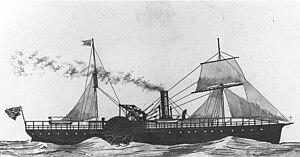USS Bienville

Watercolor by Erik Heyl, 1947, for his book
Early American Steamers, Volume I |
|
| History | |
|---|---|
|
|
|
| Name: | USS Bienville |
| Namesake: | Jean Baptiste de Bienville |
| Builder: | Lawrence & Foulks, Brooklyn, New York |
| Laid down: | date unknown |
| Launched: | 1860 at Brooklyn, New York |
| Acquired: | August 14, 1861 |
| Commissioned: | October 23, 1861 |
| Decommissioned: | soon after war’s end |
| Struck: | 1867 (est.) |
| Fate: |
|
| General characteristics | |
| Type: | Paddle steamer |
| Displacement: | 1,558 long tons (1,583 t) |
| Length: | 253 ft (77 m) |
| Beam: | 38 ft (12 m) |
| Draft: | 16 ft 2 in (4.93 m) |
| Propulsion: | |
| Speed: | 15 kn (28 km/h) |
| Complement: | 185 |
| Armament: | 1 × 30-pounder rifle, 8 × 32-pounder smoothbore guns |
USS Bienville (1861) was a 1,558 long tons (1,583 t) (burden) wooden side-wheel paddle steamer acquired by the Union Navy early in the American Civil War. She was armed with heavy guns and assigned to the Union blockade of the waterways of the Confederate States of America.
Bienville built at Brooklyn, New York in 1860. She was a two-masted sail-steamer, with a Walking beam steam engine driving a pair of side paddle wheels. The Union Navy bought her in August 1861 as part of the great expansion that took place in the first months of the American Civil War.
She was commissioned in October 1861 and soon took part in the expedition that seized future Naval bases at Port Royal and Beaufort, South Carolina. Bienville operated off the Confederacy's Atlantic coast for more than a year, taking part in the capture of positions along the Georgia and Florida shore as well as ending the careers of several blockade runners, among them the steamships Stettin (later USS Stettin) (taken on May 24, 1862) and Patras (May 27, 1862).
In 1863 USS Bienville was transferred to the Gulf of Mexico, where she continued her blockading work. She supported the capture of the entrances to Mobile Bay, Alabama on August 5, 1864. The USS Princess Royal and Bienville was stationed off the coast of Texas blockading Galveston. On the night of February 7, 1865, the two gunships sent a boat party into Galveston Bay, Texas to seize two schooners loaded with cotton. The actual prize sought was the destruction of Wren, a ship built by Laird, Son & Co. of Birkenhead (no. 317), along with sister ship (no. 318) the Lark, for Fraser, Trenholm and Company. The Wren had run aground February 6, 1865, but was freed narrowly escaping capture, and moored inside Galveston Harbor. The schooners Pet, with 256 bales of cotton on board, and Annie Sophia, with 220 bales, were anchored near the main channel at Fort Point. Acting Ensign George French was dispatched with twenty seamen and three officers to destroy the Wren and capture the schooners. Successful in capturing the schooners they were not able to get to the Wren.
...
Wikipedia
